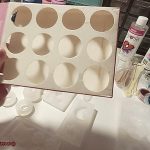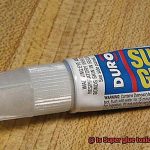We all know that staying on top of the latest trends requires some serious dedication. And when it comes to nails, we’re talking about taking our game to a whole new level. Enter fake nails – those magical little wonders that give us salon-worthy manicures right in the comfort of our own homes.
But what if you find yourself in a sticky situation, wondering if shoe glue could be the secret ingredient to keeping those falsies intact? Well, fear not my friend, because you’re definitely not alone in pondering this intriguing possibility.
In today’s blog post, we’re going to dig deep into the safety side of things and figure out whether shoe glue is a trustworthy alternative for attaching fake nails.
So grab your favorite beverage, get comfy, and let’s embark on this nail-adhesive adventure together.
What is Shoe Glue?
Contents
- 1 What is Shoe Glue?
- 2 Is Shoe Glue Safe for Fake Nails?
- 3 Potential Risks of Using Shoe Glue on Fake Nails
- 4 Alternatives to Shoe Glue for Fake Nails
- 5 How to Properly Apply Adhesive Tabs to Fake Nails
- 6 How to Remove Fake Nails Safely with Adhesive Tabs
- 7 Tips for Choosing the Right Nail Glue for Your Needs
- 8 Conclusion
Shoe glue, a specialized adhesive, is a crucial tool for bonding and repairing footwear. With its strong and long-lasting properties, it is formulated to create durable bonds on a variety of shoe materials including leather, rubber, fabric, and synthetic materials. Available in liquid or gel form, shoe glue is typically applied using a brush or nozzle.
The primary purpose of shoe glue is to mend and reconnect different parts of the shoe that may have become detached or damaged. Whether it’s the sole, upper, or insole, shoe glue provides a quick and convenient solution for fixing shoe problems without the need to purchase new footwear. It can also be utilized to repair minor tears or cracks in the shoe material, extending the lifespan of your beloved shoes.
Shoe glue’s effectiveness lies in its chemical composition. While exact formulations may vary among brands, common ingredients include polyurethane, neoprene, cyanoacrylate (also known as super glue), and epoxy resin. These powerful chemicals work synergistically to create a robust bond between the surfaces being glued, ensuring that your shoes stay intact even under heavy use.
However, it is important to remember that shoe glue is not suitable for use on human skin or nails. The adhesive properties can be too strong for delicate surfaces like nails, possibly causing damage or irritation. As a result, it is recommended to avoid applying shoe glue on fake nails or any other type of artificial nail enhancements.
Is Shoe Glue Safe for Fake Nails?
Using shoe glue on fake nails is not safe for several reasons. First, shoe glue contains harsh ingredients such as toluene, which can be harmful to the skin and nails. These chemicals are not formulated for use on nails and can cause skin irritation, allergic reactions, and even damage to the nails themselves.
Second, the strong adhesive properties of shoe glue can cause various issues when applied to fake nails. It may cause the fake nails to become firmly attached to the natural nail, making them difficult and painful to remove. This can result in nail damage and discomfort.
In addition, applying shoe glue on fake nails increases the risk of skin irritation. The chemicals in shoe glue can cause redness, itching, and inflammation on the surrounding skin.
Moreover, some individuals may be allergic to the chemicals present in shoe glue. Using it on fake nails can trigger allergic reactions such as rashes, hives, or even blistering.
Furthermore, shoe glue is designed to create a strong bond, which can make removing fake nails a challenging task. It may require excessive force or scraping, potentially causing damage to the natural nail bed.
To ensure the safety and health of your nails, it is crucial to use products specifically designed for fake nails, such as nail glue or adhesive tabs. These products are formulated to be safe and gentle on the nails while providing effective adhesion.
If you accidentally use shoe glue on fake nails and experience any adverse reactions or discomfort, it is best to remove the fake nails immediately and seek professional advice from a nail technician or healthcare provider. They can guide you on how to safely remove the adhesive and address any potential damage or irritation caused by the shoe glue.
Potential Risks of Using Shoe Glue on Fake Nails

Enhancing the beauty of our nails with fake nails is a common practice, but it’s crucial to be aware of the potential risks associated with using shoe glue. While shoe glue may seem like a convenient option, it is not designed for nail applications. In this article, we will explore the risks of using shoe glue on fake nails, including skin irritation and allergic reactions, nail damage, chemical inhalation, difficulty in removal, and the lack of safety standards. Understanding these risks will help you make informed decisions and prioritize the health of your nails.
Skin Irritation and Allergic Reactions:
- Using shoe glue on fake nails can lead to skin irritation and allergic reactions due to the chemicals it contains.
- Symptoms may include redness, itching, swelling, or a rash in the finger or nail area.
- Prolonged exposure can cause further irritation and potential damage.
Nail Damage:
- Fake nails require specific adhesive bonding agents designed for nail applications, unlike shoe glue.
- Inadequate adhesion from shoe glue can result in poor bonding between fake and natural nails.
- This can cause lifting or detachment of fake nails, potentially damaging the natural nail bed.
Chemical Inhalation:
- Shoe glues often contain volatile organic compounds (VOCs) that can be harmful when inhaled in high concentrations.
- Poor ventilation or lack of respiratory protection can lead to respiratory issues such as coughing or wheezing.
- Long-term exposure to VOCs can have adverse effects on the respiratory system.
Difficulty in Removal:
- Shoe glue creates a strong bond resistant to moisture and heat, making it challenging to remove fake nails without causing damage.
- Improper removal techniques may result in thinning, peeling, or breakage of natural nails.
Lack of Safety Standards:
Unlike nail glues formulated for nails, shoe glues lack safety standards for nail applications.
Alternatives to Shoe Glue for Fake Nails
When it comes to alternatives to shoe glue for applying fake nails, there are a variety of options that are not only safer but also more effective. Let’s delve into these alternatives and discover the best solutions for your fake nail needs.
- Nail adhesive: Designed specifically for attaching fake nails, nail adhesive is a reliable alternative to shoe glue. Available in liquid, gel, or pre-cut adhesive tabs, this specialized product provides a strong hold without damaging your natural nails. Say goodbye to the worry of harmful chemicals seeping into your nail bed.
- Nail glue: Similar to nail adhesive, nail glue is formulated exclusively for attaching fake nails. With its smaller and more precise applicator, it allows for easy and accurate application. Known for its formidable hold, nail glue ensures that your fake nails stay securely in place throughout the day.
- Double-sided tape: For those seeking a less damaging option, double-sided tape can be used as an alternative to shoe glue for fake nails. Simply cut the tape into small pieces and apply them to the back of the fake nails before pressing them onto your natural nails. This method not only protects your nails from harmful chemicals but also allows for painless removal when desired.
- Nail stickers or wraps: A fresh option gaining popularity is the use of nail stickers or wraps as an alternative to shoe glue. These thin adhesive strips or sheets come in various designs and patterns, allowing you to experiment with different nail styles effortlessly. Easy to apply and remove, they offer a temporary and non-damaging solution for those who like to change up their nail game regularly.
- Press-on nails: If you’re seeking a non-adhesive option altogether, press-on nails are the way to go. These convenient enhancements come with their own adhesive tabs or glue, eliminating the need for shoe glue entirely. Enjoy quick and temporary nail enhancements without any hassle.
Always remember to carefully follow the manufacturer’s instructions when using any alternative to shoe glue for fake nails. This ensures optimal results while keeping your natural nails healthy and unharmed.
How to Properly Apply Adhesive Tabs to Fake Nails
Properly applying adhesive tabs to fake nails is essential for achieving a secure and long-lasting manicure. Adhesive tabs are a popular alternative to traditional nail glue, as they provide a temporary hold without causing damage to the natural nails. In this article, we will explore step-by-step instructions on how to properly apply adhesive tabs to fake nails, along with some important safety tips and warnings.
Prepping Your Nails
Before applying adhesive tabs, it is crucial to properly prep your nails. Start by cleaning your nails with nail polish remover to remove any oils or residues that could affect the adhesion. This will ensure that the adhesive tabs stick securely to your nails.
Choosing the Right Size
Select adhesive tabs that are the appropriate size for your nails. They should fit snugly without extending beyond the edges of your natural nails. This will ensure a comfortable fit and prevent any discomfort or lifting.
Applying the Adhesive Tabs
Carefully peel off the backing from the adhesive tab, taking care not to touch the sticky side with your fingers. Place the tab on the back of the fake nail, ensuring that it covers the entire surface. Align the fake nail with your natural nail, starting from the cuticle area and pressing down firmly. Hold it in place for a few seconds to allow the adhesive tab to bond securely.
Securing the Fake Nails
Repeat this process for all of your nails, making sure each one is properly aligned and securely attached. Once all of the fake nails are applied, give them a gentle press to ensure they are all securely adhered. Avoid applying excessive pressure as it may cause the nails to lift or become misaligned.
Maintaining Your Fake Nails
It is important to note that adhesive tabs are not as long-lasting as nail glue, so they may not hold up as well if you are doing activities that put stress on your nails, such as typing or doing household chores. If you find that an adhesive tab starts to lose its grip or if a fake nail becomes loose, you can simply remove it and replace it with a new adhesive tab. This is one of the advantages of using adhesive tabs – they are easily replaceable.
Removing the Fake Nails
To remove fake nails attached with adhesive tabs, simply lift them gently from one side using an orangewood stick or tweezers. Avoid pulling or forceful removal, as this can damage your natural nails. After removing the fake nails, clean any residue left behind on your natural nails using nail polish remover.
How to Remove Fake Nails Safely with Adhesive Tabs
Removing fake nails safely with adhesive tabs is a popular and convenient method for those who want to avoid the use of harsh chemicals or potentially damaging techniques. Adhesive tabs, which are small, sticky strips that provide a secure hold without traditional nail glue, offer a safe and gentle alternative.
To begin the removal process, start by gently lifting up one corner of the fake nail using a cuticle pusher or an orange stick. Avoid applying too much pressure to prevent discomfort or damage to the natural nail. Once the edge of the fake nail is lifted, carefully slide a dental floss or an adhesive tab remover under the nail, using a sawing motion to loosen the adhesive.
Continue this process on each side of the nail until it is completely detached from the natural nail. Take your time and be patient to avoid any unnecessary pulling or tugging. If there is any residual adhesive left on the natural nail after removing the fake nails, you can use a gentle nail polish remover or acetone-free nail polish remover to dissolve it. Gently rub a cotton ball or pad soaked in remover over the nails until all traces of adhesive are gone.
It’s important to note that adhesive tabs may not provide as long-lasting or strong of a bond as traditional nail glue. They are ideal for temporary wear or occasions where you frequently change your nail look. If you experience any discomfort or damage to your natural nails during the removal process, it is recommended to seek professional help from a nail technician or salon.
Tips for Choosing the Right Nail Glue for Your Needs
Choosing the right nail glue for your needs is essential to ensure the safety and longevity of your fake nails. There are several important factors to consider before making your decision.
Firstly, consider the type of fake nails you will be using. Different types of fake nails require different adhesives. For example, acrylic nails need a strong adhesive that can withstand the weight and pressure of the nails, while press-on nails may require a lighter adhesive. Choosing the right adhesive for your specific type of fake nails will help ensure a secure bond.
Next, think about the duration of wear you are looking for. If you want your fake nails to last for weeks or even months, you will need a stronger and more long-lasting adhesive. On the other hand, if you are looking for a temporary solution for a special occasion, a regular nail glue that lasts for a few days may be sufficient. Consider how long you want your fake nails to stay in place and choose an adhesive that meets your needs.
It is also important to consider any allergies or sensitivities you may have. Some nail glues contain harsh chemicals that can cause irritation or allergic reactions. If you have sensitive skin or are prone to allergies, opt for a glue that is labeled as hypoallergenic or formulated for sensitive skin. This will help minimize the risk of any adverse reactions.
The consistency of the glue is another important factor to consider. Some glues are thicker and more gel-like, while others are thinner and more liquid. The consistency of the glue can affect how easy it is to apply and how well it adheres to the nail surface. Consider your application technique and choose a consistency that works well for you.
Finally, do some research and read reviews before purchasing nail glue. Look for feedback from users with similar needs to get an idea of the performance and durability of different products. This will help you make an informed decision and choose a nail glue that meets your requirements.
fUk0-MlOKr0″ >
Conclusion
In conclusion, it is crucial to recognize that shoe glue is not a safe option for fake nails. While this adhesive may work wonders for fixing your favorite pair of shoes, its potent formula and aggressive chemicals make it far from suitable for delicate nail surfaces. The consequences of using shoe glue on fake nails can range from skin irritation and allergic reactions to nail damage, chemical inhalation, and even difficulties in removal.
To ensure the utmost safety and well-being of your nails, it is imperative to turn to products specifically designed for fake nails, such as nail glue or adhesive tabs. These alternatives offer a secure hold without causing any harm to your natural nails or the surrounding skin. Opting for nail adhesive, nail glue, double-sided tape, nail stickers or wraps, or press-on nails will provide you with safer options that deliver effective adhesion.
When applying adhesive tabs to your fake nails, take care in preparing your natural nails by thoroughly cleaning them with nail polish remover. Choose adhesive tabs that fit snugly on your natural nails and apply them meticulously on the back of the fake nail, pressing firmly onto your natural nails. Should an adhesive tab lose its grip or if a fake nail becomes loose over time, simply remove it and replace it with a fresh adhesive tab.
Removing fake nails attached with adhesive tabs requires gentle handling. Begin by lifting one corner of the fake nail using a cuticle pusher or an orange stick. Slide dental floss or an adhesive tab remover beneath the nail to loosen the adhesive gradually. Repeat this process on each side until the fake nail is completely detached from the natural one.
Always remember to select an appropriate nail glue based on factors such as the type of fake nails you are using, desired duration of wear, any allergies or sensitivities you may have, consistency preferences, and user reviews.






